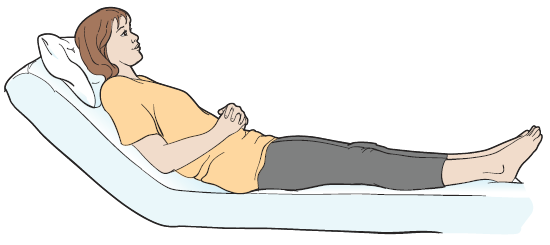The Nurse Notices That the Tube Feeding Has Stopped Infusing
How to Prevent Aspiration
Time to Read: About 2 minutes
This information explains what you can do to prevent aspiration when you're eating, drinking, or tube feeding.
Back to topAbout Aspiration
Aspiration is when food or liquid goes into your airway instead of your esophagus. Your esophagus is the tube that carries food and liquid from your mouth to your stomach. Aspiration can happen when you're eating, drinking, or tube feeding. It can also happen when you're vomiting (throwing up) or when you have heartburn.
You may be at risk of aspiration if you have trouble swallowing. This is because food or liquid can get stuck in the back of your throat and go into your airway. Aspiration can lead to pneumonia, respiratory infections (infections in your nose, throat, or lungs), and other health problems.
Signs of aspiration
Signs of aspiration include:
- Coughing
- Choking
- Gagging
- Throat clearing
- Vomiting
You and your caregiver should watch for these signs before, during, and after you eat, drink, or tube feed.
If you have any of these signs, stop eating, drinking, or tube feeding. Call your healthcare provider right away.
Back to topPreventing Aspiration
Follow these guidelines to prevent aspiration when you're eating and drinking by mouth:
- Avoid distractions when you're eating and drinking, such as talking on the phone or watching TV.
- Cut your food into small, bite-sized pieces. Always chew your food well before swallowing.
- Eat and drink slowly.
- Sit up straight when eating or drinking, if you can.
- If you're eating or drinking in bed, use a wedge pillow to lift yourself up. You can buy a wedge pillow online or at your local surgical supply store.
- Stay in an upright position (at least 45 degrees) for at least 1 hour after you eat or drink (see Figure 1).

Figure 1. Sitting up at a 45-degree angle
- If possible, always keep the head of your bed elevated using a wedge pillow.
Follow these guidelines to prevent aspiration if you're tube feeding:
- Sit up straight when tube feeding, if you can.
- If you're getting your tube feeding in bed, use a wedge pillow to lift yourself up. You can buy a wedge pillow online or at your local surgical supply store.
- Stay in an upright position (at least 45 degrees) for at least 1 hour after you finish your tube feeding (see Figure 1).
- If possible, always keep the head of your bed elevated using a wedge pillow.
Pacing Your Feedings
To help prevent aspiration, it's important to pace your feedings. Follow the guidelines below during your feedings to make sure you're not taking in more than you can digest:
- If you're tube feeding using the bolus method, don't infuse more than 360 milliliters (mL) of formula per feeding. Infuse each bolus feeding over at least 15 minutes.
- If you're tube feeding using the gravity method, don't infuse more than 480 mL of formula per feeding. Infuse each gravity feeding over at least 30 minutes.
- If you're tube feeding into your small intestine (duodenum or jejunum), don't infuse formula faster than 150 mL per hour through your feeding pump.
If you have any questions, call your Clinical Dietitian Nutritionist at 212-639-7312 or Nutrition Advanced Practice Provider (APP) at 212-639-6984.
Back to topWhen to Contact Your Healthcare Provider
Contact your healthcare provider if you have any of the following:
- Any signs of aspiration, such as coughing or gagging
- A fever of 100.4° F (38° C) or higher
- Trouble breathing
- Wheezing
- Painful breathing
- A cough with mucus
If you're having problems breathing or any other emergency, call 911 or go to your nearest emergency room right away.
Back to topSource: https://www.mskcc.org/cancer-care/patient-education/how-prevent-aspiration
0 Response to "The Nurse Notices That the Tube Feeding Has Stopped Infusing"
Enregistrer un commentaire